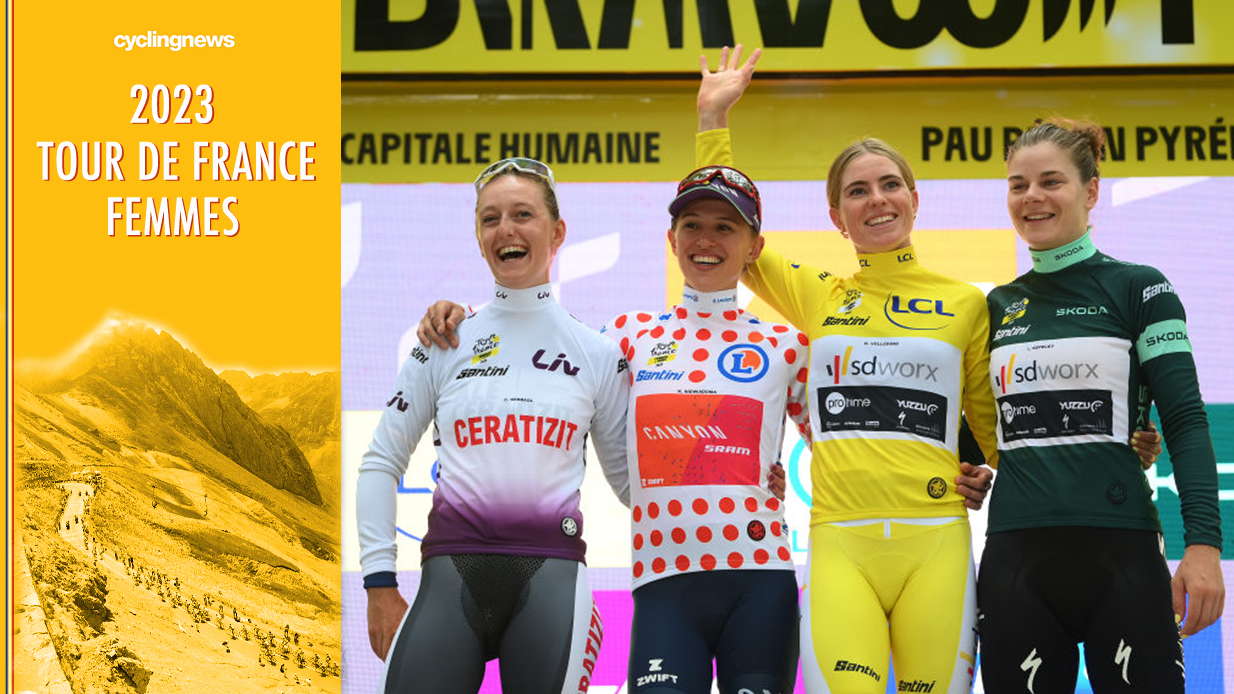
To summarise the eight days of racing at the 2023 Tour de France avec Zwift in one word could be attempted with 'thrilling'. From the first decisive breakaway by Lotte Kopecky that put her in yellow to the final weekend with a winning attack on Col du Tourmalet by eventual champion Demi Vollering, it was a full week of action with unexpected story lines each day.
The punctuation mark of the Tour was delivered by the Dutch squad in the stage 8 time trial in Pau, as Vollering finished second and stood on the stage podium between her teammates Marlen Reusser and Lotte Kopecky. All eight days saw the yellow jersey on the shoulders of just two SD Worx teammates, and Kopecky also took the green jersey and second overall. Team SD Worx won four of eight stages with four different riders.
However, the race had a plethora of pivotal moments and an abundance of unpredictable outcomes, including Vollering overcoming a 20-second time penalty, two race directors being tossed from the race, and sprinter Charlotte Kool (dsm-firmenich) and defending champion Annemiek van Vleuten (Movistar) remaining winless.
Positive stories included Kasia Niewiadoma's strong performance to claim the mountains classification and a spot on the podium, finishing just 21 hundredths of a second behind Kopecky for third overall. There was a different stage winner each day, with some even scoring their first professional win on the world's biggest stage.
And French fans proved they love Le Tour, be it the men's race or the women's race. They were rewarded with exciting performances by French riders such as Audrey Cordon-Ragot (Human Powered Health), who was the virtual leader on stage 4, Juliette Labous (Team dsm-firmenich), who finished fifth overall, and Cédrine Kerbaol (Ceratizit-WNT), who won the best young riders jersey.
Cyclingnews Women's Editor Kirsten Frattini and contributor Lukas Knöfler were on the ground at the Tour de France Femmes to capture the highlights of the race.
SD Worx race through controversy, end up on top
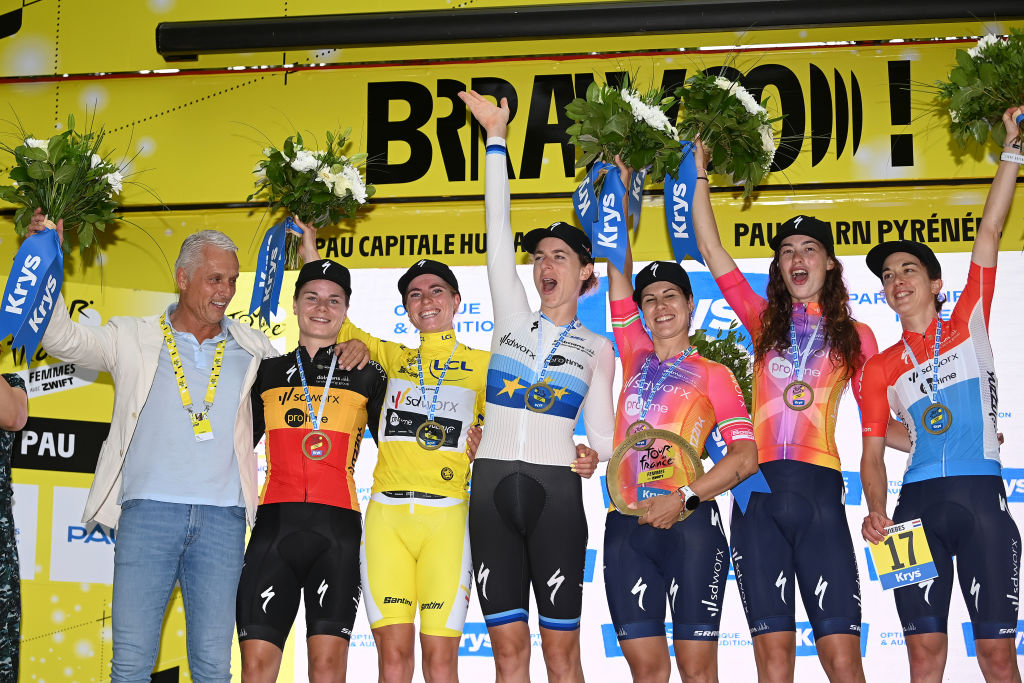
Team SD Worx came into the second edition of the Tour de France Femmes with one goal - to win the yellow jersey. However, their road to get there was not as smooth as many might have expected.
Off to a winning start, Lotte Kopecky, who said she initially was added to the roster as a support rider, made a late-race attack and held off a chasing peloton to win the opening stage in Clermont-Ferrand, taking the event's first yellow jersey.
Minutes after crossing the finish line, however, rival teams expressed disappointment in the SD Worx tactics, accusing their riders of blocking the chase behind Kopecky.
Members of the peloton also accused SD Worx of not taking up the chasing responsibilities while in yellow on stage 3, on a day that worked out entirely in SD Worx's favour, with Lorena Wiebes winning the bunch sprint into Montignac-Lascaux.
"If we were not the team, but a different team was winning everything, I would be frustrated, too. That's, of course, what is happening to the other teams," SD Worx Director Anna van der Breggen said of the complaints made against her riders in the open stages.
Then on stage 4 into Rodez, Vollering crossed the line in second place but thought she had won. She raised her arms in a somewhat hesitant victory salute, but officials soon informed her that breakaway rider Yara Kastelijn (Fenix-Deceuninck) had already won the race over a minute earlier. The silver lining was that Demi Vollering had gained eight seconds on rival Van Vleuten.
Vollering's task was made exponentially more challenging given the controversial circumstances surrounding her team after she was docked 20 seconds on stage 5 and her director Danny Stam was kicked off the Tour. Although Kopecky was still in the yellow jersey, the controversy and stress on the team began to show in the mood outside the team bus.
However, come stage 7, when Vollering crested the summit of the iconic Col du Tourmalet, all complaints and controversy appeared to be forgotten as she gained nearly two minutes on her rivals and all but secured the yellow jersey ahead of the final day of racing.
The team's celebrations peaked when Marlen Reusser, Vollering and Koepcky went 1-2-3 in the closing time trial, and Vollering sealed the overall victory at the Tour de France Femmes. In total, the team won four stages and Kopecky won the green points jersey and finished second overall.
"We got a lot of shit about us, sometimes not correctly, but sometimes correctly. But I'm very happy that Demi has 'put the dots on the i'. I'm glad it's not about the 20 seconds," Kopecky said. (KF)
The defining moment: La Géante Demi Vollering emerging from the mist on the Tourmalet
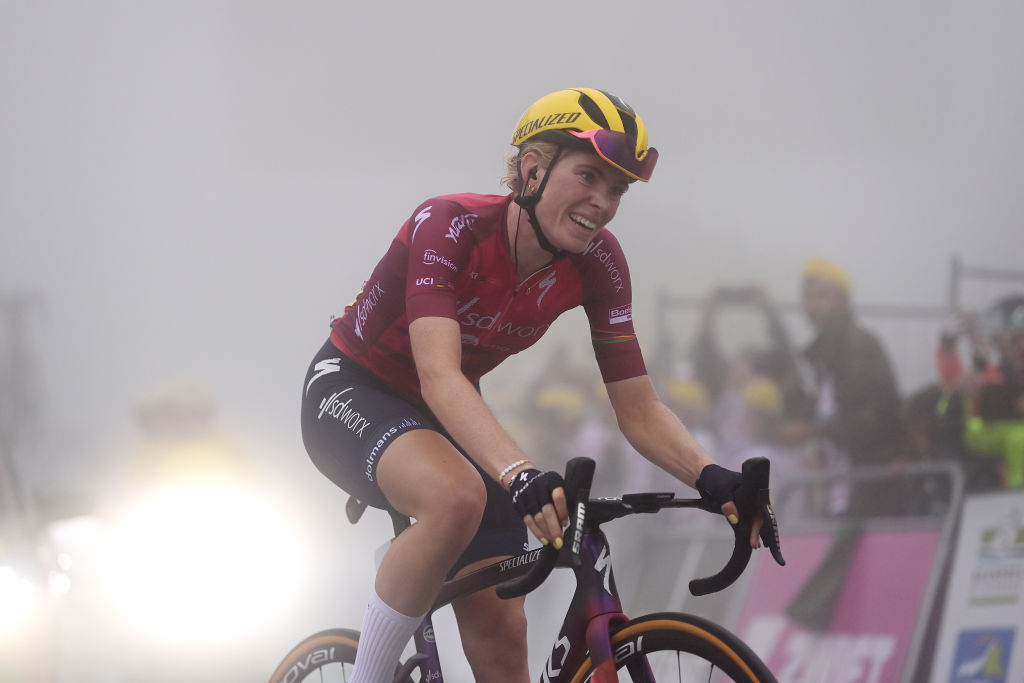
The mountaintop finish on the Col du Tourmalet, the first Pyréenées climb ever included in the men’s Tour de France, was the most-anticipated stage of the race. And it held up to expectations with a panache-powered solo attack from Kasia Niewiadoma (Canyon-SRAM) on the descent from the Col d’Aspin before Demi Vollering (Team SD Worx) destroyed her competition on the Col du Tourmalet to take the stage and the yellow jersey.
The weather with low-hanging clouds and extremely limited visibility on the final climb only served to increase the momentousness of the stage. When Vollering emerged from the mist and pushed through the last hairpins on the final kilometre, her mouth wide open as she was gasping for air at over 2000 metres of altitude. She looked like Le Géant (The Giant), the famous statue of a climbing cyclist that is installed at the top of the Col du Tourmalet – she was La Géante. This image has already become part of the legend that surrounds the Tour de France and will be talked about for decades to come. (LK)
Race jury cracks down
After each of the eight stages of the Tour de France Femmes avec Zwift, the official race communique included long lists of team staff and riders who had violated the rules of the race. Fines were handed out for riders' carelessly disposing of waste or directors maneuvering incorrectly among the caravan.
In other more severe incidents, the race jury held a strict stance on regulations surrounding drafting and riders' safety that saw time penalties and even disqualifications at this Tour de France Femmes.
An incident on stage 4 into Rodez saw two motorbikes try to pass the day's breakaway on narrow roads. The first passed Kathrin Hammes (EF Education-TIBCO-SVB), but the second clipped her handlebars with its large rigid plastic panniers.
The CPA Women initially urged that the moto driver and photographer be removed from the race after anger and critical comments swept across social media. However, some of the riders in the breakaway defended and forgave the photographer's motorbike; they received a 200 CHF fine instead.
The most dramatic incident during the eight days of racing happened on stage 5 when the race jury handed Demi Vollering (SD Worx) a 20-second time penalty for drafting back into the caravan after a flat tire. The following day, the race jury notified the team's director Danny Stam that a decision had been made to remove him from the race for dangerous driving and inappropriate comments he made toward the commissaires panel.
The race jury also disqualified Lotta Henttala for holding onto the team car during stage 6 into Blagnac. AG Insurance-Soudal-QuickStep's director sportif Servais Knaven, who was driving the team vehicle then, was also excluded from the race. The team later admitted that Henttala held onto a water bottle for 10 seconds, which they regretted, but denied that she held on to the team car.
Stam argued that these types of violations happen daily at the men's Tour de France and mostly go unnoticed by the race jury. However, just because it happens all the time in men's racing doesn't make it right, and the race jury at the women's Tour de France showed they were serious about the race rules. (KF)
'Play the game, but also play the poker'
At this Tour de France Femmes, some moments illustrated why patience and being able to 'play the game of poker' could lead to a successful outcome.
Team dsm-firmenich was one of the teams that missed out on a victory at this Tour de France Femmes. Their sprinter Charlotte Kool came close with a third place on stage 1 into Clermont-Ferrand and was second on stage 6 into Albi, but she had prepared all season for a victory.
She and her team will likely reflect upon her seventh place on stage 3 into Montignac-Lascaux the most after this race. There will also be some learning lessons on navigating a race against a powerful team like SD Worx, including their former rider and world's best sprinter Lorena Wiebes.
SD Worx and Wiebes used their inside knowledge to outfox Team dsm-firmenich and gambled on the likelihood that they would chase lone attacker Julie van de Velde (Fenix-Deceuninck).
In a masterful game of poker, SD Worx let Team dsm-firmenich burn their matches in the chase, only coming through to close the gap entirely in the last moments of the race, with Wiebes winning the bunch sprint.
"Sometimes, you have to gamble. We also found ourselves in this situation many times where we had to lead the chase. It's part of the game," Wiebes said.
Movistar's Annemiek van Vleuten later praised SD Worx for their success in the Tour de France Femmes' opening stages but said she hoped to see more teams active and reacting to the dominant Dutch team during the eight-day race. But she also noted the importance of holding back and allowing the team to do the work.
"In the end, it always surprises me that some teams are going to help SD Worx for the victory. It's happening during the races, but it makes you think, 'play the game, but also play the poker.'
"SD Worx are good at poker, and I have to shout out to them because they are good at the poker game. It may be time for the other teams to play the poker. It would be more smart." (KF)
Annemiek van Vleuten gracious in defeat
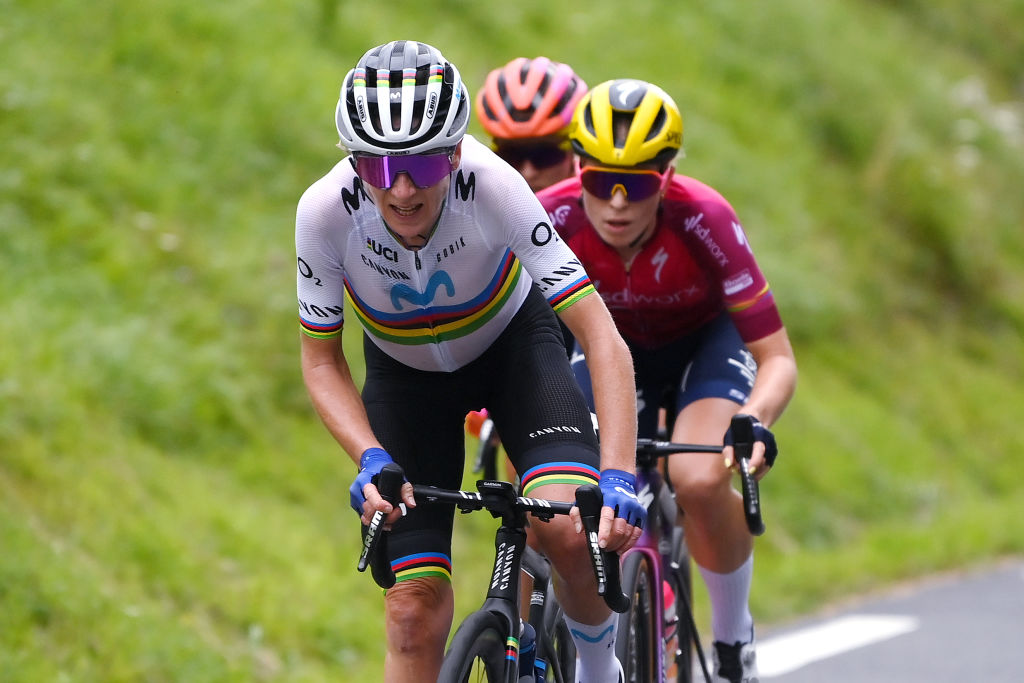
Annemiek van Vleuten (Movistar) went into the season with an ambitious goal of winning all three grand tours. While she succeeded at La Vuelta Femenina and the Giro d'Italia Donne, she was upset to have finished just off the podium in fourth place at the Tour de France Femmes.
Despite feeling disappointed in her own performance, of which she said she felt unwell with stomach problems in the decisive final two stages, Van Vleuten was gracious in her defeat, congratulating and praising Demi Vollering and SD Worx on their overall success.
"Demi Vollering was super good, the whole [SD Worx] team, they did super well. She is a young rider, and it is not easy to have so much pressure on your shoulders. I can also feel the pressure. I'm 40, and I can also feel the pressure, and I'm a bit more used to it," Van Vleuten said.
"She can deal with the pressure, and it's not easy in the Tour de France; there's a lot of tension, so shout out to her that she can handle it already at such a young age. She had an amazing performance."
Van Vleuten also praised her teammates - Liane Lippert and Emma Norsgaard - for their two stage wins at the Tour, calling them memorable moments. "I think we achieved a lot of beautiful memories," she said of the team at the Tour de France Femmes, and her last three seasons at Movistar.
Van Vleuten will next compete at the World Championships in Glasgow, where she lines up as the defending champion but revealed that she will not be the Dutch team leader. She will instead work for Vollering and Lorena Wiebes in their pursuit of the road race world title.
Van Vleuten is set to retire at the end of this season after a sparkling 16-year career in pro cycling. (KF)
French riders excel
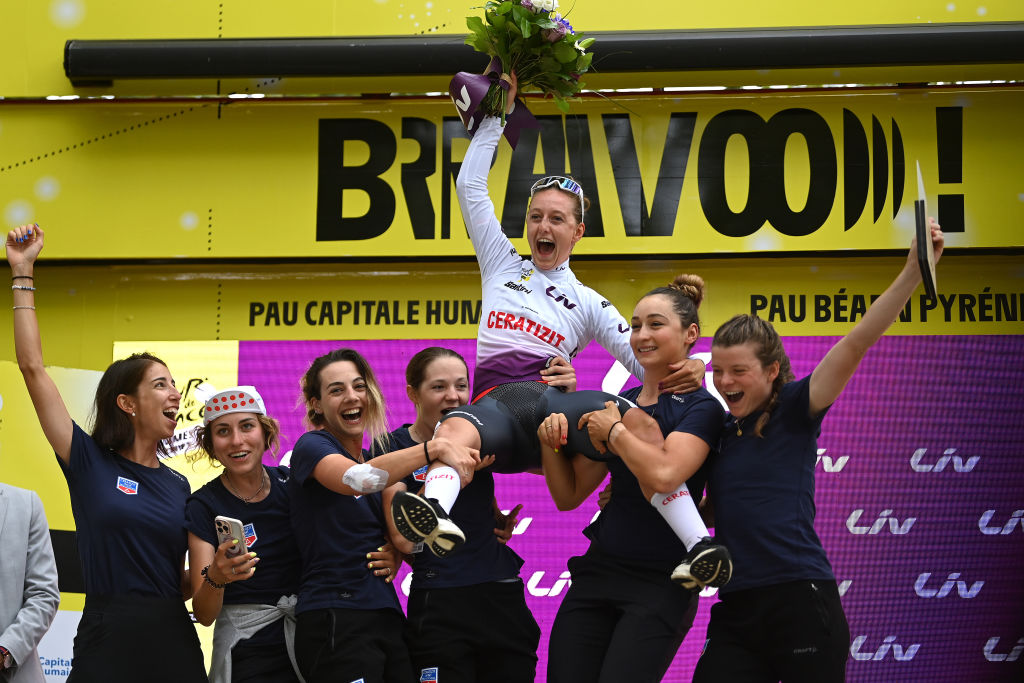
The French riders may not have been the main characters as the race played out on the biggest stage of women’s cycling, but they took on important supporting roles without which the 2023 Tour de France Femmes would not have been the same.
Marie-Morgane Le Deunff (Arkéa Pro Cycling Team) was the first rider to attack in the 2023 Tour de France Femmes, and the French riders kept on attacking to join breakaways. Audrey Cordon-Ragot (Human Powered Health) was one of them and was in the maillot jaune virtual for much of stage 4 when a 14-rider breakaway was given a huge advantage on the longest-ever stage in Women’s WorldTour cycling. \
In the end, Yara Kastelijn (Fenix-Deceuninck) dropped Cordon-Ragot to briefly take the virtual lead herself and win the stage, but the Frenchwoman was happy with her performance after a crazy year. After winning the French championships in June, Cordon-Ragot suffered a stroke in late 2022, the team she had signed with for 2023 collapsed in December, and when Zaaf Cycling Team, the team she signed for in the last minute, turned out not to have funds to pay their riders, she moved to her current team in April.
“When we had ten minutes, I really thought about it. But I knew I would have to drop or follow Kastelijn. She went for the stage win, but I gave it all I had, and I have no regrets. I’m always bouncing back from big difficulties, but that’s what I do and will continue to do. There are people who have it way worse than me, there is a war in Ukraine, they are suffering much more than I am,” Cordon-Ragot put things into perspective the day after she made every French cycling fan dream.
Cédrine Kerbaol (Ceratizit-WNT) took the white jersey of the best U23 rider on stage 1 and defended it all the way to Pau, becoming the first French rider to win a classification jersey in the resurrected women’s Tour. And last but by no means least, Juliette Labous (Team dsm-firmenich) finished fifth overall after being runner-up at the Giro d’Italia Donne, confirming once more that she is France’s big stage race hope. (LK)
A well-designed parcours
Clermont-Ferrand was proud of hosting not one, but both Tours de France in 2023, with banners in the city announcing “2 Tours selon rien” (2 Tours or nothing). The parcours from the city in the Massif Central to Pau crossed varying terrain and was designed very well, not giving any one type of rider a big advantage over another and favouring complete riders for the general classification while also offering opportunities for three breakaway victories. And despite the large time gaps on stage 7 to the Tourmalet, the finishing ITT in Pau still played a role as Lotte Kopecky moved from fourth to second overall after losing the maillot jaune to her teammate Demi Vollering the day before.
In the 2022 edition, the race visited the Vosges and the Jura. In 2023, it came to the Massif Central and the Pyrénées, with the queen stage finishing on the Col du Tourmalet. The logical next step would be the Alps, more specifically the Savoie, Haute-Savoie, and Isère départements. The 2024 edition features the race’s first foreign Grand Départ in Rotterdam, and the southern Alps would simply be too far away for the race to reach without exorbitant transfers. La Super Planche des Belles Filles in 2022 and the Col d’Aspin and Col du Tourmalet in 2023 suggest that the ASO is keen to include at least one very famous climbs every year, so the race might come to Alpe d’Huez next year. The success of the finishing ITT could even mean a final ITT up the famous hairpins like the one in the men’s Tour de France in 2004.
Other Alpine climbs like the Col de Galibier (ideally from the Valloire side with the Col de Télégraphe as an ‘appetiser’) or Col de la Madeleine, the Mont Ventoux in the Provence, a return to the Pyrénées, but climbing the Port de Balès or other more easterly cols, and maybe even a finish on the Puy de Dôme may be in the future for the Tour de France Femmes. (LK)
To the French public, it's simply the Tour de France
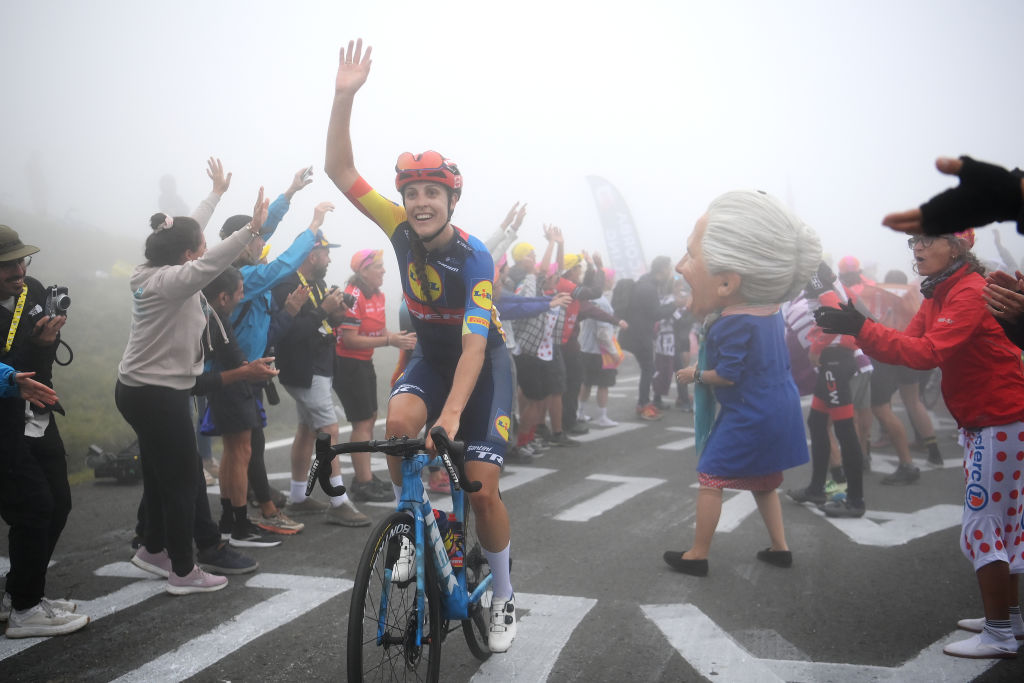
Everyone we spoke to during these nine days in France referred to the race as simply “the Tour de France”. No distinction was made between the men’s and women’s race, whether it was the signs outlining parking restrictions in the start and finish towns, the postman in Maurillac who was overjoyed to have the race come to his hometown, or the riders themselves. A bike race is a bike race is a bike race, and the Tour is the Tour is the Tour.
The roadside crowds waved to every car that came through on the race route and cheered on every rider with the same enthusiasm, and children like Antoine on stage 6 had an even better chance to meet their stars up close and personal than they would at the men’s Tour. All this shows that the argument that women’s cycling isn’t as attractive as men’s races simply doesn’t hold up: If you build it, they will come. (LK)






